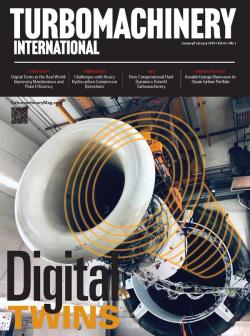
OR WAIT null SECS
© 2024 MJH Life Sciences™ and Turbomachinery Magazine. All rights reserved.
Combined Torsional-Lateral Vibration
FAILURE TO INSTALL TORSIONAL VIBRATION TRANSDUCERS AND SENSORS IS A COMMON MISTAKE IN TURBOMACHINERY
In turbomachinery consisting of several machine casings or those using nonmetallic flexible couplings (with low torsional stiffness), torsional natural frequencies can be lower than lateral natural frequencies. In such cases, these torsional natural frequencies are usually within a similar range of operating speeds. In these turbomachinery trains, combined torsional- lateral vibration could result in serious issues and even destruction.
Rotors are the principal source of vibration. Most malfunctions originate from the direct transfer of rotational energy into vibrational energy. Lateral modes and torsional vibration of the rotor are the principal concerns.
In most turbomachines, torsional natural frequencies are higher than lateral mode natural frequencies. Typical forcing functions (except those with gear transmissions and those with variable speed drivers) do not usually excite torsional vibrations. The situation can change, however, if torsional natural frequencies are lower than lateral ones and within the same range of operating speeds.
This can happen in complex turbomachinery with several machine casings or trains using a flexible rubber-element coupling, for example. Shaft asymmetry, radial load and unbalance affecting the position of the bending and the twisting centerlines constitute the coupling factors between torsional and lateral modes.
Analytical asymmetric rotor models which take into consideration lateral and torsional coupling are used to model torsional- lateral coupled vibration. The lateral dynamic formulations include the coupling terms with torsional vibration, which represent the balance of moments for the shaft torsional mode.
These analytical models contain periodically variable coefficients, which could affect torsional stiffness. Such analytical equations produce parametric resonances, which usually occur at rotating speeds coinciding with 1, 1/2, 1/4, 1/6, 1/8, and other fractions of the torsional natural frequency. Since unbalance and radial load forces (interfering with an asymmetric shaft) constitute the actual system forcing functions in torsional-lateral vibration, the highest torsional mode resonances can occur at one and two times the rotor speed.
Torsional-lateral modes exhibit peak responses at lateral and torsional natural frequencies. While lateral mode peaks are not very high (lateral mode damping is relatively high), torsional resonant vibrations can exhibit significant amplitudes (since the effective damping in torsional mode is usually low).
“Failure to recommend routine installation of torsional vibration transducers and sensors is a common mistake.”
Therefore, failure to recommend routine installation of torsional vibration transducers and sensors is a common mistake in turbomachinery. In particular, it is a significant weakness in more complex turbomachinery trains. Poorly damped torsional modes can be excited through a coupling (or a long shaft) with lateral modes contributing considerably to a stress increase which may significantly intensify the level of coupling and shaft cracking.
Torsional vibration changes, in fact, could reveal symptoms of an impending crack at much earlier levels compared with lateral vibrations. In other words, torsional vibration monitoring (and identification of any change in torsional vibration) is recommended for all turbomachinery, but especially machines with relatively low torsional natural frequencies.
An important sensor in condition monitoring is the phase angle reference sensor (the key phasor which is used to monitor rotating speed and the phase of rotor responses). The key phasor sensor ties rotor vibration data to its rotational motion. The information provided is valuable for condition monitoring and in diagnosing various machine malfunctions.
In one of its simplest forms, for example, this instrument could be a proximity sensor observing equally spaced, tooth-like markers on the rotor (typically 36 or 72 markers). An additional subtraction of signals from two such sensors mounted at different axial locations provides some estimates on torsional vibrations.
In order to eliminate the effect of lateral vibrations on torsional responses, one more sensor is mounted at 180-degree position at each location. Data from the two sensors can then be combined for torsional vibration measurement.



